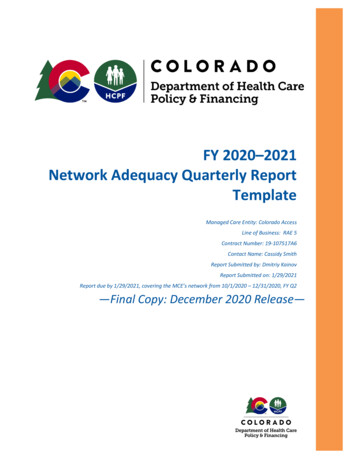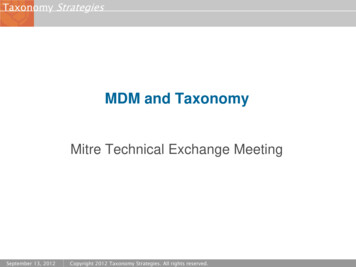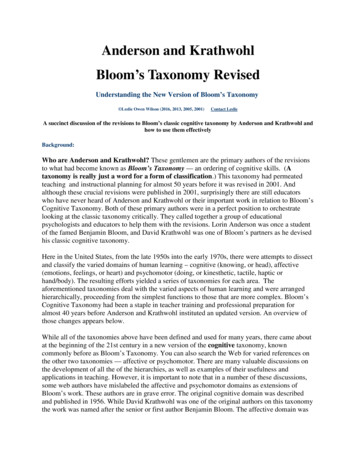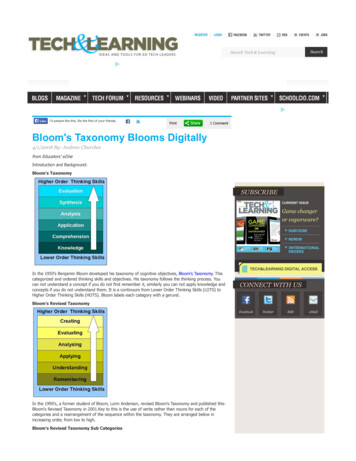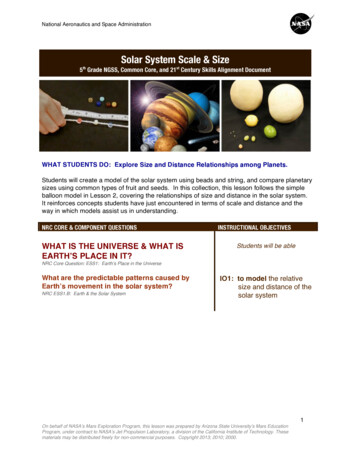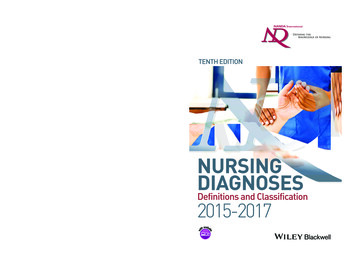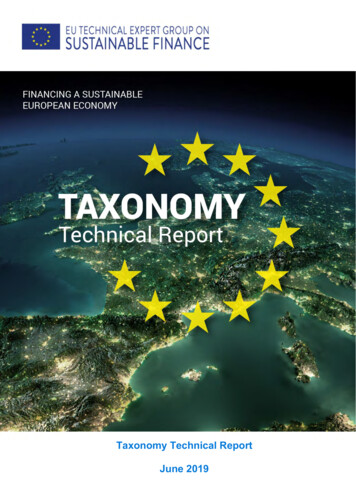
Transcription
Taxonomy Technical ReportJune 2019
DisclaimerThis report represents the overall view of the members of the Technical ExpertGroup, and although it represents such a consensus, it may not necessarily, on alldetails, represent the individual views of member institutions or experts. The viewsreflected in this Report are the views of the experts only. This report does not reflectthe views of the European Commission or it services.2
About this documentThis document sets out the results of the work to date undertaken by the Technical Expert Group onSustainable Finance (hereafter, ‘TEG’) in relation to the development of an EU classification systemfor environmentally sustainable economic activities (hereafter ‘Taxonomy’). It has six parts:PART AExplanation of the Taxonomy approach. This section sets out the role and importanceof sustainable finance in Europe from a policy and investment perspective, the rationalefor the development of an EU Taxonomy, the daft regulation and the mandate of theTEG.PART BMethodology. This explains the methodologies for developing technical screeningcriteria for climate change mitigation objectives, adaptation objectives and ‘do nosignificant harm’ to other environmental objectives in the legislative proposal.PART CTaxonomy user and use case analysis. This section provides practical guidance topotential users of the Taxonomy, including case studies.PART DEconomic impacts of the Taxonomy. This section provides the TEG’s analysis of thelikely economic impacts of establishing an EU Taxonomy.PART ENext steps for the Taxonomy. This section elaborates on unresolved issues andpotential ways forward for the Taxonomy and the technical work of the Platform onSustainable Finance.PART FFull list of technical screening criteria. This annex sets out the sector- and economicactivity-specific technical screening criteria and rationale for the TEG’s analysis.3
Contents1.2.Context and rationale . 101.1An introduction - Why have an EU Taxonomy? . 101.2Background - The EU environment and climate action framework . 111.3The role of sustainable finance . 12The Technical Expert Group . 162.13.Mandate and work to date . 16Principles for Taxonomy development . 193.1Principles enshrined in regulation . 193.2Additional principles developed by TEG . 224.Sector framework . 235.Economic and environmental systems . 246.Climate change mitigation . 267.8.6.1Work process – conceptual approach . 266.2Methodology for selecting sectors and economic activities . 276.3Defining substantial contribution to climate change mitigation . 296.4Eligibility of finance for activities contributing substantially to mitigation . 316.5Mitigation activities table . 34Climate change adaptation . 367.1Work process – conceptual approach . 367.2Defining substantial contribution to climate change adaptation . 387.3Adaptation screening criteria . 407.4Eligibility of finance for activities contributing substantially to adaptation . 417.5Classification of climate-related hazards . 417.6Sectoral sensitivity to climate hazards . 427.7Adaptation activities table . 44Do no significant harm (DNSH) . 458.1DNSH to climate change adaptation (for other environmental objectives) . 458.2DNSH to environmental objectives 3-6 . 469.Climate change mitigation worked example . 4910.Climate change adaptation worked example . 524
11.Users of the Taxonomy . 5611.1 Defining the users . 5711.2 Obligations for Taxonomy users . 6112.Implementation matters. 6212.1 General implementation approach . 6212.2 Differences by asset classes . 6512.3 Case Studies . 6613.Data: availability analysis and results . 7113.1 Revenue breakdown by Taxonomy-related activities . 7113.2 Environmental data . 7114.Role of companies . 7514.1 Advantages of reporting to facilitate the implementation of the Taxonomy . 7515.Role of data providers . 7716.Expected impacts of the Taxonomy . 7916.1 Coverage of the Taxonomy and financial quantitative impact assessment . 7916.2 Qualitative analysis of the transmission channels of the Taxonomy . 9516.3 Cost and benefit analysis for relevant stakeholders . 9716.4 Conclusions . 10317.The extension of the TEG and development after TEG . 10417.1 TEG extension . 10417.2 Ongoing development beyond the TEG . 1055
18.List of activities with technical screening criteria. 10718.1 Summary: climate change mitigation . 10718.2 Summary: climate change adaptation . 11019.Agriculture . 11120.Forestry . 15621.Manufacturing . 18322.Electricity, gas, steam and air conditioning supply . 23223.Water, Sewerage, Waste and Remediation . 29224.Transportation . 32425.Information and communication . 35726.Construction, Real estate activities . 36327.Agriculture, Forestry and Fishing . 38728.Electricity, gas, steam and air conditioning supply . 39329.Water supply; sewerage; waste management and remediation activities . 40130.Information and communication . 40631.Financial and insurance activities . 40832.Professional, scientific and technical activities . 4116
List of Technical Expert Group MembersMembers of the Technical Expert Group are listed below. Taxonomy Working Group members are inbold.OrganisationNameAIG EuropeDawn SLEVINAllianz Global InvestorsSteffen HOERTERBloombergCurtis RAVENEL1BNP Paribas asset managementHelena VIÑES FIESTASBorsa ItalianaSara LOVISOLOCarbone 4Jean-Yves WILMOTTECassa Depositi e Prestiti S.p.A.Pierfrancesco LATINICDP (Carbon Disclosure Project)Nico FETTESClimate Bond InitiativeSean KIDNEYClimate KICSandrine DIXSON-DECLEVEEACBTanguy CLAQUINEFFASJosé Luis BLASCOEnBW AGThomas KUSTEREREurelectricJesús MARTÍNEZ PÉREZFinance WatchLudovic SUTTOR SOREL2Green Finance Cluster FrankfurtKarsten LOEFFLERGRI (Global Reporting Initiative)Eszter VITORINOICMANicolas PFAFFKfW BankengruppeKarl Ludwig BROCKMANNLuxembourg Stock ExchangeFlavia MICILOTTA3MirovaManuel COESLIERMSCIVeronique MENOUNordeaAila AHOPRINathan FABIANRICSUrsula HARTENBERGER4SCORMichèle LACROIXSEBMarie BAUMGARTSSwiss Re LtdClaudia BOLLIThomson ReutersElena PHILIPOVAUnileverMichel PINTOWiseEuropaMaciej BUKOWSKIWWFJochen KRIMPHOFFAndreas HOEPNER5Brenda KRAMER6Paolo MASONI71 Occasionally replaced by Ani Kavookjian2 Replacing Nina Lazic and Mireille Martini3 Replacing Jane Wilkinson4 Replacing Zsolt Toth5 Appointed in a personal capacity6 Appointed as a representative of a common interest shared by stakeholders7 Appointed in a personal capacity7
Directly invited membersEuropean Banking AuthorityPilar Gutiérrez, Piers Haben, Mira Lamriben,Slavka EleyAna Sofia Melo, Fabio TamburriniLázaro Cuesta Barberá8, Marie ScholerEuropean Central BankEuropean Insurance and OccupationalPensions AuthorityEuropean Investment BankEila Kreivi, Aldo Romani, Nancy Saich, PeterAnderson, Dominika Rosolowska, Jean-LucFilippini, Cinzia LosennoAlessandro D’Eri, Roxana Damianov MicheleMazzoni, Eduardo-Javier Moral-Prieto, ChantalSourlas, Jacob LönnqvistAndreas Barkman, Stefan SpeckEuropean Securities Market AuthorityEuropean Environment AgencyDirectly invited observersEuropean Bank for Reconstruction andDevelopmentOrganisation for Economic Cooperation andDevelopmentNetwork for Greening the FinancialSystem/Banque de FranceUnited Nations Environmental ProgrammeFinance InitiativeCarel CronenbergSimon Buckle, Mireille MARTINILisa Biermann9Elodie Feller10TEG members have benefitted from extensive support from within their own organisations.Acknowledgements are given below.Member staff acting in TEG rolesClimate Bonds InitiativeClimate-KICAnna CreedFelicity Creighton SporsAdditional support from TEG member and observer organisationsAni KavookjianBloombergLuca Di MarcoCassa Depositi e PrestitiDiletta GiulianiClimate Bonds InitiativeKatie HouseClimate Bonds InitiativeUjala QadirClimate Bonds InitiativeLionel MokClimate Bonds InitiativePenny ApostolakiClimate Bonds InitiativeDaniel ZimmerClimate-KICCraig DaviesEBRDIoanna KourtiEBRDBogachan BenliEIBJuan BofillEIBMarcial BustinduyEIB8 Replacing Camille Graciani9 Replacing Emmanuel Buttin10 Replacing Eric Usher8
Adrian EnacheAndres GaviraStephane PettiChristian SchemppJulio SchreierJohn SinnerMarcos TejerinaMarc TontelingJonas WolffAndreas UnterstallerDoris MarquardtGorm DigeNikolaj BockLale KarayakaMagdalena JozwickaWouter VanneuvilleIoannis BakasStefan SpeckIan MarnaneSebastian RinkDoris KramerJosef HaiderChloe DesjonqueresMichael MullanMireille MartiniAlyssa HeathDanielle ChesebroughGemma JamesMatilda PerssonJames KavanaghFabrizio VarrialeJonathan GheyssensZofia WetmanksaEIBEIBEIBEIBEIBEIBEIBEIBEIBEuropean Environment AgencyEuropean Environment AgencyEuropean Environment AgencyEuropean Environment AgencyEuropean Environment AgencyEuropean Environment AgencyEuropean Environment AgencyEuropean Environment AgencyEuropean Environment AgencyEuropean Environment AgencyGreen Finance Cluster GermanyKfW Bankengruppe (KfW)KfW Bankengruppe (KfW)OECDOECDOECDPrinciples for Responsible Investment (PRI)Principles for Responsible Investment (PRI)Principles for Responsible Investment (PRI)Principles for Responsible Investment (PRI)Royal Institution of Chartered Surveyors (RICS)Royal Institution of Chartered Surveyors (RICS)UN REDDWiseEuropaThe TEG is also grateful to the generous and extensive technical support from consultationrespondents and additional experts, as well as the in-depth contributions from the sectoral EuropeanCommission Directorates and Joint Research Centre of the European Commission. Additionalexperts who contributed to the process are listed on the EU Sustainable Finance website. Additionalexperts provided evidence and expertise to inform deliberations by the TEG, but additional experts arenot responsible for TEG recommendations.9
Explanation of the Taxonomy approachThis section sets out the role and importance of sustainable finance in Europe from a policyand investment perspective, the rationale for the development of an EU Taxonomy, the draftregulation and the mandate of the TEG.1.Context and rationaleAn introduction - Why have an EU Taxonomy?In committing to the SDGs and climate-related goals through the Paris Agreement, the EU and itsMember States endorsed a direction for sustainable growth. These goals provide signals tocorporations and investors about future economic trends, investment opportunities and risks, but it isonly the alignment of public policies to the goals that will encourage capital markets to re-orient capitalflows.Through financing or investments and through the stewardship of investments, investors will influencethe decisions taken by corporations and other entities. This chain of influence requires translation ofpolicy goals into frameworks that the investors and managers of capital can respond to. The EUTaxonomy is one example of such a framework: a list of economic activities assessed and classifiedbased on their contribution to EU sustainability related policy objectives.The EU Taxonomy is an implementation tool that can enable capital markets to identify and respond toinvestment opportunities that contribute to environmental policy objectives. Decisions by investors toallocate capital or influence company activities will be making a substantial contribution to climategoals and to the related SDGs.This report provides the basis for the EU Taxonomy. It presents a list of economic activities which canmake a substantial contribution to climate change mitigation and criteria to do no significant harm toother environmental objectives. It also presents a framework for evaluating substantial contribution toclimate change adaptation. The list of economic activities covered in this report is not exhaustive andadditional activities should be added to the Taxonomy in future.The Taxonomy proposed in this report is readily useful to investors, but the benefits of widespread useof the Taxonomy as a common language and reference point for markets, requires transparency byinvestors and companies alike. There is an important role for practical, disclosure-based regulation tohelp inform financial decision making and enable market participants to respond to the EU’s goals forfinancing sustainable growth.10
Background - The EU environment and climate action frameworkSustainable development and the protection and improvement of the quality of the environment arecore values of the European Union (EU) and recognized by EU laws and treaties. The Treaty of theFunctioning of the European Union (TFEU) requires all proposals by the Commission to include a highlevel of environmental protection.11The EU’s first Environment Action Programme was adopted in 1972. Successive programmes haveresulted in over 50 directives, regulations and decisions on environmental protection covering airquality, waste management, water protection, chemical control, integrated pollution prevention andcontrol and natural habitats protection‘A deep re-engineering of the financial system isnecessary for investments to become moreMany environmental policies have evolved intosustainable and for the system to promote trulystrategic programmes that recognise the needsustainable development from an economic,for mainstreaming environmentalsocial and environmental perspective. Thisconsiderations into key ‘driver’ policy areasimplies finding ways to integrate sustainabilitysuch as agriculture, transport, energy, industry,into the EU’s regulatory and financial policyproduct policy and regional/structuralframework and to mobilise and orient moredevelopment. The EU has been developingprivate capital flows towards sustainablepolicies to limit air pollutants, including carboninvestments. The 17 Sustainable Developmentemissions, and improve energy efficiency sinceGoals (SDGs) identified in the UN 2030 Agendathe early 1990s. The EU has also played afor Sustainable Development provide aleading role in the development of internationalframework for directing such investments, whichclimate and sustainable development policy,the EU is fully committed to implementing.with a strong commitment to key internationalagreements such as the United NationsAmong other long-term sustainability challenges,Framework Convention on Climate Changemanaging climate change depends on making(UNFCCC), the United Nations Convention onfinance flows consistent with the long-termBiological Diversity (UNCBD) and the Uniteddecarbonisation objectives and climate-resilientNations Convention to Combat Desertificationdevelopment. The Paris Agreement, which(UNCCD), Sustainable Development Goalsmarked a watershed in global commitment to(SDGs), the Paris Agreement on climatetackling climate change, put finance at the heartchange, the Sendai Framework for Disasterof this policy.’Risk Reduction and the Kigali Amendment tothe Montreal Protocol.Mid-Term Review of the Capital MarketsUnionPrivate finance is critical to achieve many ofthese goals, but a significant investment gapremains. 12 Action is required to bridge the gap.11 Article 11 states: ‘Environmental protection requirements must be integrated into the definition and implementation ofthe Union's policies and activities, in particular with a view to promoting sustainable development’. Article 114 furthermorerequires the Commission to ‘take as a base a high level of protection’ concerning health, safety, environmental protectionand consumer protection. Under Article 191, EU policy on the environment shall contribute to pursuit of the followingobjectives: preserving, protecting and improving the quality of the environment protecting human health prudent and rational utilisation of natural resources promoting measures at the international level to deal with regional or worldwide environmental problems,particularly combating climate change12This is discussed in Section 1.2.2 and in detail in Part D: Impact Assessment.11
These goals are directly reflected in the environmental, social and economic policies of the EU. Theimportance of the SDGs and the Paris Agreement are specifically recognised in the 2017 update to theCapital Markets Union13 (see call out box) and the 2018 Action Plan on Financing SustainableGrowth.14On climate policy specifically, the EU has set targets for reducing its greenhouse gas (GHG)emissions progressively up to 2050, with specific milestones in 2020 and 2030. The EU is currently ontrack to meet the targets for 2020.15 The European Council agreed on climate and energy targets for2030 in 2014.16 The renewables and energy efficiency targets were then revised upwards as part ofthe legislation adopted in 2018. The key targets for 2030 are: at least 40% cut in greenhouse gasemissions (based on 1990 levels); at least 32% share for renewable energy; at least 32.5%improvement in energy efficiency.17In November 2018, the Commission presented its strategic long-term vision for a prosperous, modern,competitive and climate-neutral economy by 2050.18 Reaching net-zero GHG emissions by 2050(climate neutrality) is considered an appropriate EU contribution to limiting the global temperatureincrease to well below 2 degrees Celsius and pursuing efforts to limit the temperature increase to 1.5degrees Celsius, in line with the Paris Agreement objectives. The EU aims to adopt and submit anambitious strategy by early 2020 to the UNFCCC as requested under the Paris Agreement. 19In 2013, the European Commission adopted an EU strategy on adaptation to climate change. It aimedto enhance the preparedness and capacity of all governance levels to respond to the impacts ofclimate change and make Europe more climate resilient. In 2015, the EU signed onto a new globalgoal on adaptation as part of the Paris Agreement, and works towards a wider and moreinterconnected policy agenda defined by the 17 UN Sustainable Development Goals.Meeting EU environment and climate change objectives has required the comprehensive reassessment of EU policies in related areas, including those related to the functioning of the Europeanfinancial system.The role of sustainable financeSustainable finance is a key element of EU policies, including those on Investment and Growth,Climate and Energy and Environment and the Capital Markets Union. 20 This reflects a growingawareness that sustainable economic development, employment and environmental goals such asclean air and a safe climate must be in alignment.The EU is at the forefront of global financial system reforms that aim to incorporate sustainability,which now encompasses central bank market supervision and green finance policies in China,throughout ASEAN and in Latin America, among others (e.g. Morocco). This progress followssubstantial investment in competency and ideas and a growing desire for sustainable finance.13 cation-cmu-mid-term-review-june2017 en.pdf.14 on-plan-sustainable-growth en.15 gress en.16 9-2014-INIT/en/pdf.17 0 en.18 pages/com 2018 733 en.pdf.19 0 en.20 aper-towards-sustainable-europe en.12
1.3.1 High Level Expert GroupAt the end of 2016, the European Commission appointed the High-Level Expert Group (HLEG) onSustainable Finance with a mandate to recommend financial reforms on which to base the EU strategyon sustainable finance.21 The group, composed of members and observers from banking, insurance,asset management, stock exchanges, financial industry associations, international institutions and civilsociety began work in January 2017 and delivered their final report in January 2018. The reportincludes eight key recommendations and several cross-cutting and sector-specific recommendationsto align the financial system with sustainability goals.The HLEG’s first recommendation was to ‘establish and maintain a common sustainability Taxonomyat the EU level’:22If Europe is to mobilise capital at scale for sustainable development, it needs a technicallyrobust classification system to establish market clarity on what is ‘sustainable’. This systemwould cover a wide range of activities, investments and assets that can be clearly linked to theParis Agreement and the Sustainable Development Goals (SDGs).Such a ‘sustainability Taxonomy’ would identify under which conditions or criteria any giveninvestment or financial product will contribute to the EU’s sustainability objectives. TheTaxonomy would enable market growth by re-orienting capital flows towards assets thatcontribute to sustainable development; by creating much needed comparability acrossstandards, labels, products and jurisdictions; and by enabling market participants to invest insustainability with greater confidence and ease.The HLEG proposed a detailed framework for the development of a future Taxonomy and presented aproposal for the climate change mitigation elements of this Taxonomy.231.3.2 Action Plan to finance sustainable growthBuilding upon the HLEG’s recommendations, on 8 March 2018 the EU Commission published itsAction Plan: Financing Sustainable Growth,24 stating the need for a deep rethink of the Europeanfinancial framework. The Action Plan describes the EU strategy for sustainable finance and is part ofthe implementation plan of Article 2(1)(c) of the Paris Agreement, relating to the alignment of financialflows with global climate goals and the UN 2030 Agenda for Sustainable Development.The European Commission proposal for a long-term decarbonisation strategy25 estimates increasedinvestment in Europe’s energy system and infrastructure from the current 2% of GDP per annum to2.8% of GDP to reach net-zero emissions, an additional 175 to 290 billion a year. This is consistentwith the Intergovernmental Panel on Climate Change (IPCC) special report that estimated that of 2.5%of world GDP will be needed for the energy system between 2016 and 2035. To achieve this, privatesector financial flows must be directed towards low emission investments.The 10 initiatives set out in the Action Plan aim to: Reorient capital flows towards sustainable investment, in order to achieve sustainable andinclusive growth.21 sustainable-finance-final-report en.pdf.22 ainable-finance-report en.23 sustainable-finance-final-report-annex-3 en.pdf.24 i CELEX:52018DC0097.25 A Clean Planet for all - A European strategic long-term vision for a prosperous, modern, competitive and climate neutraleconomy. 0 en13
Manage financial risks stemming from climate change, environmental degradation and socialissues.Foster transparency and long-termism in financial and economic activity.As highlighted in the Action Plan, achieving the goal of re-orienting capital flows towards sustainableinvestment should be underpinned by an EU classification system that provides a common languageon what constitutes sustainable activities. Clarity is needed on the criteria an economic activity mustmeet to qualify as positively contributing to EU sustainability objectives.Currently, there is no EU classification system for sustainable economic activities and the existingmarket-based practices are not necessarily aligned with EU environmental and sustainability policyobjectives.Economic transition to meet climate policy objectivesTo avoid dangerous anthropogenic interference within the climate system, the Paris Agreementcommits countries to limiting the global temperature increase to well below 2 degrees Celsiusand to pursue efforts to limit the temperature increase to 1.5 degrees Celsius. Additionally, theagreement aims to strengthen the ability of countries to deal with the impacts of climate change.The IPCC special report on the impacts of global warming above 1.5 degrees recognises thatambition over the next decade is critical for climate change mitigation and adaptation. TheEuropean Commission’s long-term decarbonisation strategy proposes that Europe aim forcarbon neutrality by 2050 as part of global efforts to reach these goals. The EU AdaptationStrategy aims to make Europe more climate resilient and enhance the preparedness andcapacity of all governance levels to respond to the impacts of climate change.The transition to a net-zero emissions economy requires transitioning from high to low emittingactivities. To achieve this, it is necessary to incentivise the growth of very low carbon and netzero activities, while at the same time achieving substantial emissions reductions in otheractivities. There is a need to redirect capital to activities that can provide substan
Commission Directorates and Joint Research Centre of the European Commission. Additional experts who contributed to the process are listed on the EU Sustainable Finance website. Additional experts provided evidence and expertise to inform deliberations by the TEG, but additional experts are not responsible for TEG recommendations.
